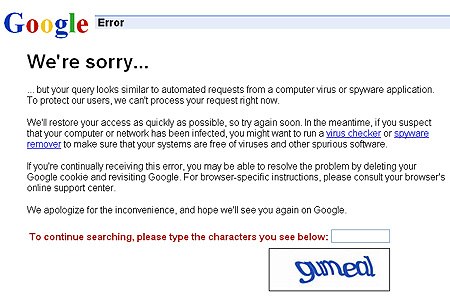
from billy at Loshadka
"Fratres" by Arvo Pärt
Drony, haunting medieval-modern classic played with two SID chips. About 10 minutes--very nicely done. There is a version for a .sid file player but I just downloaded the .mp3. The arrangement is by Linus Åkesson. The organ sounds produced by the chip make the piece reminiscent of early Terry Riley.
Thanks to drx from Bodenstandig 2000 for mentioning this.
Thanks to Paddy Johnson for the plug on her page and for using my artwork in her masthead. Just to be totally "meta," I added a couple of notes to her text.
"The piece is meant to be big, dumb, and iconic, a moving, pulsing symbol of both the promise and failure of technology," said Tom Moody of OptiDisc* during Geeks in the Gallery, a detail of which now resides in my masthead. Aesthetically the gif looks just as Moody describes it, the rings klutzy yet mildly hypnotic; though past this, its life as a meme underscores the artist’s excitement and reservations about the web as a medium. Referencing artists such as Kenneth Noland and Jasper Johns, without reiterating color field painting or Minimalism, Optidisc speaks as clearly to a tradition of Fine Art painting, as it does regular surfers looking for something "different" for their myspace page.**
* The wall-sized projected version.
** This version of the GIF has "gone viral," meaning it has been used on scores of MySpace, YouTube, and LiveJournal pages, and as a web graphic and avatar. (example) I have been collecting screen shots wherever it appears and I have 60 so far (the ones that hotlink the image from my server). I'm saving them out of simple boredom/vanity but also for a work in progress--more "meta" web stuff. Here's a group of thirty screen shots on my studio floor.
This is a first for me. Some of the political blogs were talking about Clinton and Obama courting superdelegates and a joke was going around about a roof deck and Scarlett Johansson. I missed the reference so I googled those terms and got this message, which I've never seen before:

End of an era--no more quick solutions to current in-jokes. Paddy also has some complaints about Google mail. I never signed up for that because I didn't like the invasive advertising tie-ins. It takes a spammer to know a spammer.
As the Tides Turned: Hollywood in 1967 Through the Lens of Five Films ["The Graduate," "In the Heat of the Night," "Bonnie and Clyde," "Guess Who's Coming to Dinner," and "Dr. Doolittle"--all Oscar best pic nominees for that year]
This article in today's New York Times about the above-titled, recently published book by Mark Harris makes very little sense--don't know if it's bad writing or too-heavy editorial redaction. Wrote some paragraphs (in boldface) to try to shore up what seem rather significant gaps or flaws in Janet Maslin's story published online today. The addendum is completely invented, but that's what happens when newspapers don't tell proper stories--people fill in their own facts.
The movies' new eagerness to push the envelope in 1967 is illustrated in different ways by "Bonnie and Clyde" and "The Graduate." In tribute to that spirit of change, "Pictures at a Revolution" begins as an aficionado of the French New Wave, Robert Benton, stole away from his job as Esquire's art director to watch "Jules and Jim" on an afternoon in 1963. Intrigued by a sense of wide-open opportunity, and working on the four- to five-year development process that seems par for the course, Mr. Benton and his partner, David Newman, were inspired to write "Bonnie and Clyde" in hopes of persuading François Truffaut to direct it.
They came reasonably close.
After two years of effort, miscommunications, and scheduling conflicts, Truffaut agreed to direct the picture. But star Warren Beatty, described by one of Harris' interviewees, Robert Evans, as a "towering Hollywood ego," wanted American Arthur Penn to direct. As an attempt at compromise, Mr. Benton also interviewed Louis Malle, Jean-Pierre Melville, and other continental heavyweights for the director slot, but ultimately Beatty prevailed.
Even Mr. Penn thought he was the wrong choice, and initially he sided with Mr. Benton against Beatty. With the years has come a change in perspective, and he now says, "Warren was right, the movie needed an American director. A French auteur would always have too much irony about these trashy American bandits."
Nevertheless it was a learning process for the fledgling writer and Mr. Benton acknowledges to Harris that "I'm glad I went through it."
And when the flirtation of "Bonnie and Clyde" with New Wave directors brought Mr. Truffaut and his friend Jean-Luc Godard together for a screening of a crime-spree film from the late '40s, Mr. Benton remembers thinking he was as close to heaven on earth as he would ever be.
"He now believes I was right?" Warren Beatty, the film’s star and producer, asks Mr. Harris about Arthur Penn, who directed "Bonnie and Clyde." "That’s funny, because I now believe I was wrong." Here and throughout "Pictures at a Revolution," there is a sense of reassessment and new perspective, with Mr. Harris as a thoughtful, unobtrusive catalyst for his interviewees' reflections.
Maslin also claims "Mr. Harris has his share of hair-raising particulars about, say, Rex Harrison (whose unhinged and abusive Dr. Dolittle seemed in need of his own doctor)" without telling us what any of them are--that's journalistic malpractice, right there.